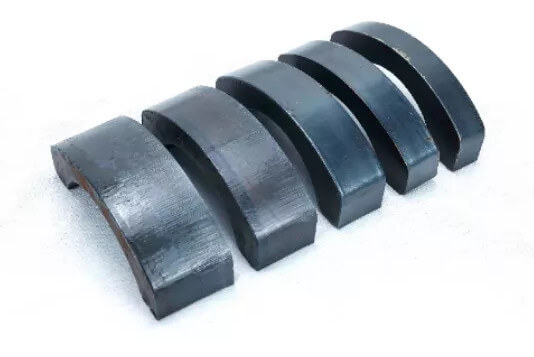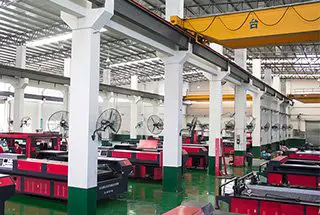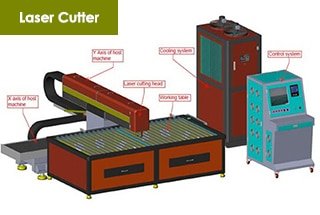“10,000 watts” has been a highly sought-after topic in the laser industry in the past two years.
Currently, the 10,000 watt laser has been increasingly recognized and accepted by the market.
During this time, we have received feedback from some users regarding challenges they faced during the commissioning of the 10,000 watt laser cutting process.
To address these difficulties, we have compiled a list of common problems and provided corresponding solutions for your reference.
Commissioning method of cutting process of thick carbon steel plate
- To debug the cutting process of carbon steel with fiber laser cutting machines that have a power over 10,000 watts, start by referring to the cutting process parameter table to achieve a bright surface on the thickest carbon steel and stabilize the cutting process for the thickest carbon steel.
- After adjusting the perforation process parameters, ensure that the cutting efficiency and quality meet your requirements.
- After adjusting the cutting and perforation process, carry out a small batch cutting to verify the consistency of the process and its effect.
Common Problems and Solutions Table for Debugging Cutting Carbon Steel with 10,000+ Watt Laser
| Thickness&surface | Problem | Solutions |
|---|---|---|
| 25mm bright surface 30mm bright surface 40mm frosted surface | Cutting nozzle heating | 1. Increase nozzle size |
| 2. Clean the lens if the lens is dirty | ||
| 3. Lower the cutting focus | ||
| Rough cutting surface | 1. Raise the cutting focus | |
| 2. Reduce nozzle size | ||
| 3. Reduce cutting gas | ||
| 4. Increase cutting speed | ||
| Cutting slag hanging | 1. Improper cutting speed | |
| 2. Increase the cutting air pressure | ||
| 3. Improper cutting focus | ||
| Inconsistent cutting surface | 1. The nozzle outlet is not round | |
| 2. The laser is not in the center of the nozzle |

16-40mm carbon steel cutting effect
Commissioning method of cutting process of thick stainless steel plate
- For lasers with a power over 10,000 watts, refer to the laser cutting process parameter table and start by debugging the cutting effect on stainless steel with varying thicknesses.
- After adjusting the perforation process parameters, ensure that the cutting efficiency and quality meet your requirements.
- After adjusting the cutting and perforation process, carry out small batch cutting to verify the consistency of the process and its effect.
Common Problems and Solutions Table for Debugging Cutting Stainless Steel with 10,000+ Watt Lasers
| Thickness&surface | Problem | Solutions |
|---|---|---|
| 6mm: no slag hanging 20mm: slag point | Cutting layered | 1. Reduce dam cutting speed |
| 2. Increase dam cutting pressure | ||
| 3. Increase the size of nozzle | ||
| 4. Improper cutting focus | ||
| slag hanging | 1. Improper cutting speed | |
| 2. Increase the cutting air pressure | ||
| 3. Reduce the negative focus | ||
| Slow efficiency | 1. Dirty lens | |
| 2. Increase the cutting air pressure | ||
| 40mm: small amount of slag hanging | Cutting layered | 1. Reduce frequency |
| 2. Raise the positive focus | ||
| 3. Increase the cutting pressure | ||
| Yellow cutting surface | 1. Reduce the duty cycle | |
| 2. Raise the positive focus | ||
| 3. Increase the cutting air pressure |

10-70mm stainless steel cutting effect
Test method for cutting stability
To ensure the stability of the equipment during mass production and maintain consistent product quality, stability tests should be conducted prior to formal batch processing.

Test method for cutting stability of 10000 watt laser
| Testing material | 6-10mm stainless steel | Test graphics | Helical line |
|---|---|---|---|
| Testing time | 5-10min | Test gas | Nitrogen |
| Testing method | 1. Adjust the stainless steel cutting parameters to ensure that the cutting surface is free of slag and stratification | ||
| 2. Cut continuously at full power for 5-10min to check whether the cutting surface is consistent; | |||
| 3. In case of increasing slag hanging, blue light after cutting for a period of time, continuous cutting and other problems, it indicates that the cutting focus is offset. It is necessary to check the cutting head lens (dirty lens, poor lens quality, thermal lens problem) and the focus position. | |||


